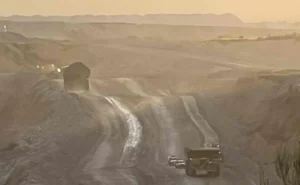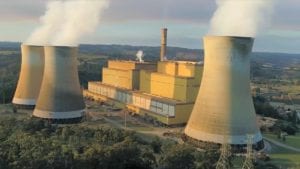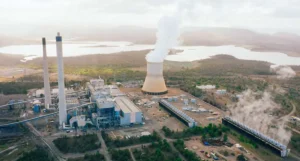In Australia, decarbonisation is just politics to politicians. Neither the Coalition nor the ALP take climate change seriously. It is just a political tool or a political problem and provides few photo opportunities.
Why do the likes of Matt Canavan support a coal fired power station in Collinsville? It’s because it’s a political wedge in Queensland. Partly a wedge
of the ALP, but partly a wedge by disaffected elements of the National Party against the current National Party leader.
Never mind $5 billion per year of tourism revenue in North Queesnsland. Never mind the jobs and investment from renewable electricity. Never mind the costs of climate change.
What are those costs? An excellent opinion article in the AFR by Adrian Blundell Wignall points out that Australia accounts for 5.9% of global loss events related to climate change, even though we only account for 1.3% of direct emissions. That is, our global risk is more than five times our global share of emissions. Blundell Wignall provided the following chart:

As well as the clear link of temperature and events you can see it’s water-related events (floods, cyclones, storms) that are the main issue today.
Queenslanders might be lobbying AEMO to make the North Queensland renewable energy zone a priority hub. Probably getting a DC transmission line built to the load centres around Brisbane and further South.
Lots of jobs, skilled jobs in that. Every study of minimizing the long-term cost of a highly renewable NEM comes to the same conclusion regarding the value of wind in Queensland and the value of winter sun in Queensland to the rest of the NEM. That’s high value renewable electricity going to waste due to a lack of political pressure from Queenslanders.
Why does the Coalition want to support a nuclear industry? How does that do anything for jobs or for the economy? How is that in the national interest?
The Coalition supports nuclear because supporting the alternative – much cheaper, simpler and more immediately available firmed wind and solar -would mean admitting they were wrong all along in renewable energy reliability, security and economics.
And of course they were wrong and continue to be wrong. Every economist, every electricity industry executive knows that. In short, the pigheaded refusal of the government to just go with the “consensus” view is the main problem.
But one valid point about coal is its importance to Australia’s exchange rate as one of our largest exports. Australia’s four biggest exports are coal, LNG, iron ore and inbound tourism. They are all negatively impacted by climate change and so, in my view, we need to adjust.
Also, one can be supremely confident because the physics demand that whatever is supposed to happen by 2050 will actually happen by 2040 at the latest. So time to get cracking. That’s the national interest.
So what follows is just a quick look around the main thermal coal markets in Asia to get a sense of what headwinds are already apparent.
A run around Asia – coal generation faces headwinds in every country
In summary. There is still significant coal generation development going on in Asia but as a general statement it’s running into headwinds. Either electricity demand is not growing fast enough to absorb new capacity (China and Japan), or renewables are eating into profits and policy is restrictive (South Korea and to an extent India).
Investors are right to question the economics of new coal generation in many of the main markets. S&P Global Platts Analytics has forecast the seaborne trade for thermal coal for 2019 at 994 million tonnes and for 2020 at 1.015 billion tonnes.
Demand for thermal coal has dwindled from Far East consumers such as Japan, South Korea and Taiwan, dropping by about 12 million mt year on year, which is similar to the drop seen in Europe. Source: Platts November 2019.
Australia is about 200 mt of the seaborne trade thermal market, 20% of the total, sending product mostly to Japan and China, the two markets where new coal fuelled electricity is likely to be under the most profit pressure.
Last year the Reserve Bank noted that the more developed Asian countries are starting to pull back from coal fuelled electricity but the less developed countries are pushing on. They also tend to buy the cheapest coal available which means less energy and more waste/byproduct/pollution per tonne of use.
Australia tends to export less of the low quality coal, although NSW generators are happy to expose the NSW population to it.
The IEA clearly has a different definition of thermal coal to Platts but the message is similar, the only real area of growth is South Asia, that is Vietnam, Cambodia, Pakistan and India. Those countries tend to buy low quality coal mainly from Indonesia. But Indonesia is presently not forecast to grow supply.
According to the IEA – not always the most reliable forecaster says Ma Kettle to Pa Pot, but in this case I am of similar view – Australia is forecast to be the single largest contributor to the growth in seaborne trade over the next six years, and half of that is Adani.



CHINA
Here are the actual numbers for China electricity production as reported by China’s statistics Bureau. China’s thermal coal imports are about 20% of the 1 billion tonne global total and the largest single driver of global prices.
Imports in 2019 were about 300 mt and on an underlying basis (exclude virus) probably flat in 2020.
1. Thermal, that is coal-fired electricity has grown a touch slower than overall electricity consumption and thermal’s share of total output has reduced by maybe 2%. In addition, the fleet has become more efficient further reducing coal consumption and CO2 emissions. Even so, the increase in coal generation exceeds the increase in all other electricity sources over the five years;
2. The increase in nuclear growth has been as strong as the increase in wind, essentially doubling production.
3. The growth rate in both wind and solar output (excludes behind the meter) has sharply declined in the past couple of years.
4. The increase in coal generation has well exceeded the increase in domestic production and that is the main driver of higher global coal prices. Perhaps the burden will now fall more on India and Vietnam.
China’s consumers pay more than those in Australia at the generator level
The increase in coal-fuelled generation has not benefitted electricity producers. China pays higher electricity prices at the generator level than Australians pay.
The share prices of the major producers have collapsed and they now essentially survive only by the good graces of their debt providers.
Share prices have completely collapsed and are still falling. China can’t allow this to go on. Yet what is the alternative, as coal has to be imported. The only way to improve profits in the current system is to allow prices to rise. But prices are already high.
Profitability will decline further as new production comes on line. China’s government is not stupid and it’s clear something needs to give.
On Paper the new RPS standard means 35% of China’s electricity to come from renewables by 2030
One of the more interesting slides at last weeks 100% renewable conference at ANU was that showing that China’s revised RPS = renewable percentage scheme which started in 2020 implies 35% renewables in China’s electricity mix by 2030.
Unfortunately, detail on this is nearly impossible to come by. If we include hydro, solar and wind as at 2019 the share was 23%. Hydro won’t grow so it does seem to imply lots more wind and solar. Certificates under the scheme are apparently tradeable but as I say, good luck finding out about it.
JAPAN
1. Japan is building new coal generation plants but these can only be used to replace existing capacity because;
2. Electricity consumption in Japan is not growing so there is no room for new capacity unless old capacity closes. At the moment new coal can either replace old coal or nuclear.

Although coal-fired electricity in Japan achieves a much higher price than in China or in Australia (about AUD $ 130/MWH) its costs are also higher despite capacity utilization of around 70% rather than China’s 49%. An excellent analysis of the risks for new thermal generation in Japan can be found at: Japan stranded asset risk analysis, published October 2019.
It’s true this report is written by an organization with a decarbonization agenda and should be read with that in mind. I thought it was a carefully written analysis well worth taking seriously. The analysis suggests maybe a minor increase in demand for Australia’s coal to Japan but equally I would want a long term volume contract before committing to a new mine.
Kepco, which is basically the electricity provider in South Korea, published its capacity growth plan in an investor presentation in January, 2020. It plans to reduce coal capacity over the next 4 years and by 10% in total by 2030.
I rearranged their data into a chart combining the Group and IPP numbers and assuming that the starting IPP thermal number was all LNG. They do explicitly state that IPP assumptions are for thermal growth to be 100% LNG.
You won’t be selling much more coal to South Korea based on that plan, but you might sell them some more gas
TAIWAN
I’ve lifted this graph from Simon Nicholass’s presentation to the 100% renewables conference. It’s fairly self explanatory. Again where is the increase in
coal demand coming from?

INDIA
India is, maximum irony intended, “the great white hope” of the black coal industry. Yet here is a quote from the current Finance Minister in India
“New Delhi: India will stop importing thermal coal from financial year 2023-24, coal and mines minister Pralhad Joshi said on Tuesday” : Source: India Economic Times.
Within India most people are essentially calling the statement BS. India presently imports 182 mt of thermal coal. One trader said:
“It is an ambitious political statement as it is more expensive to move Indian domestic coal due to limited railway availability in inland India as compared to importing seaborne coal.” Source: Platts
And another trader said: “self-sufficiency of Indian domestic coal is only possible if the Indian government invests heavily on new logistics infrastructure. This is merely a policy and the government will not restrict imports of thermal coal in my opinion.” Source: Platts
It is humorous to see how little regard traders place on Indian government policy announcements.
A better , in my opinion, but still only a broad brush view, is found at: Reuters opinion column, Coal is losing to renewables. This piece was written in the immediate aftermath of the “Coaltrans India” conference. The article notes that PPAs for new renewabls are at 3 rupees/KWh,(AUD 63/MWh) whereas existing thermal is 4 rupees and new thermal 5-6 rupees/KWh.
Again, note the similarity of these prices to Australian prices. The note states that there remains 36 GW of coal generation to come online over the
next decade. These plants are being built by the state as the private sector has withdrawn from funding. As usual the willingness of entrepreneurs to build coal generation plants is high but the ability to make a profit is low (new plants are said to have a market value about half of cost).
The long and the short of that article is that both economics and policy favour renewables over coal in India but Coal financiers have a lot of money and power (sound familiar). In terms of new capacity this chart has the best recent summary I can come up with.
The chart shows considerable growth in coal capacity even if only at half the rate of renewables.
VIETNAM
On the one hand renewables are getting a good leg-up in Vietnam…
 …and on the other hand, Vietnam has been one of the world’s fastest growing source of coal generation. Imports of coal are forecast to rise from 40 mt in 2019, itself up very sharply from the previous year, to maybe 50 mt in 2020.
…and on the other hand, Vietnam has been one of the world’s fastest growing source of coal generation. Imports of coal are forecast to rise from 40 mt in 2019, itself up very sharply from the previous year, to maybe 50 mt in 2020.
Vietnam had close to 10 GW of coal capacity being constructed in 2019. In general the outlook for Vietnam’s electricity fuel composition will be driven by COP8 the central plan Vietnam is putting together and due for release around the middle of this year. The online consensus is it will represent a further strong shift away from coal towards renewables.
Analysts opine the private sector invests
In Australia it’s up to the private sector to make the investment decision. They take the risk, just don’t ask for a Government contract. Entrepreneurs make decisions and get funding.
The Galilee Basin has higher transport costs, insurance is harder to find, bank finance is harder to find and markets already face headwinds with clear signs those headwinds will increase to gale force.
 David Leitch is founder-director of ITK and a regular contributor to RenewEconomy and a co-host of its weekly Energy Insiders podcast.
David Leitch is founder-director of ITK and a regular contributor to RenewEconomy and a co-host of its weekly Energy Insiders podcast.




















